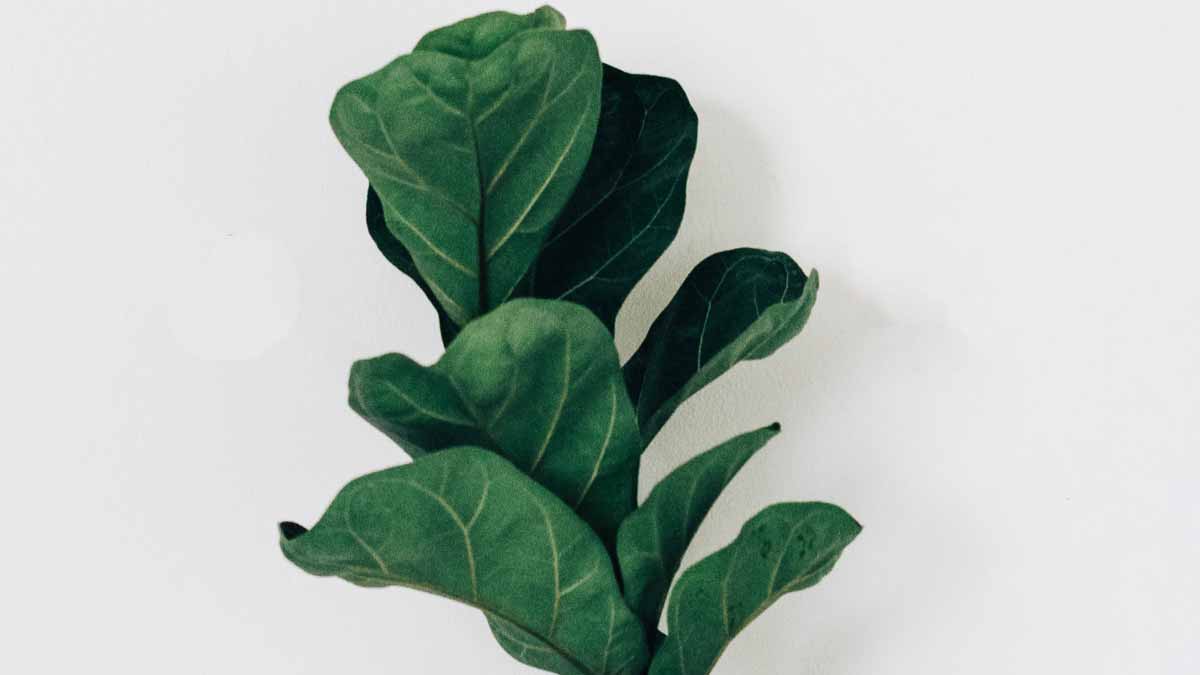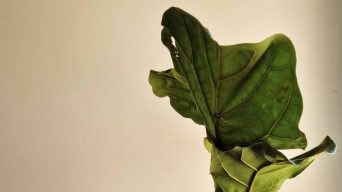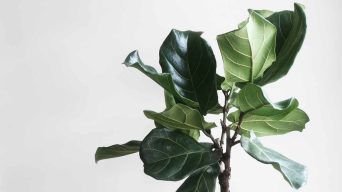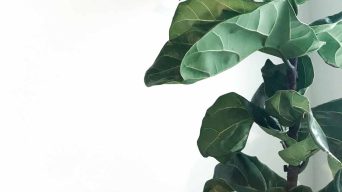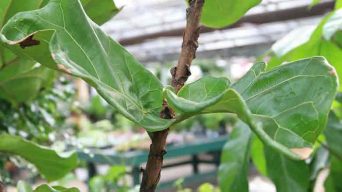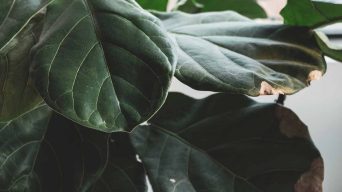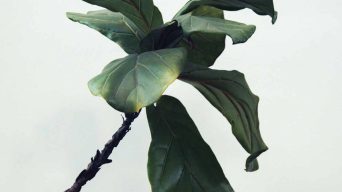A fiddle leaf fig tree (Ficus lyrata) is a beautiful sight. Its massive, glossy leaves can make any room feel more alive.
They are also notoriously finicky, but they can make even the most amateur gardener feel like a pro when they are happy.
One of the most common problems people have with their fiddle leaf fig plants is that the leaves start to fall off.
Dropping leaves can be a sign of several different problems, so it is crucial to figure out what is causing the leaves to fall off before you can fix the problem.
This article will explain why your fiddle leaf fig leaves might be falling off and what you can do to fix the problem.
What Causes Fiddle Leaf Fig Leaves to Fall Off?
There are a few reasons why this happens, and fortunately, there are also a few things you can do to fix it.
You first need to figure out why the leaves are dropping. Is it because of something you’re doing, or is it a issue with the plant itself?
Here are some of the most common reasons for leaf drop and how to fix them:
1. Overwatering
If your fiddle leaf fig plant is getting too much water, the leaves will start to drop off. This is because the roots are getting too much water and beginning to rot.
Fiddle leaf figs need to be watered about once a week or when the top inch of soil is dry.
If you water your plant more than that, the roots will start to rot, and the leaves will drop off.
Cut back on how often you water your plant to fix an overwatered fiddle leaf fig. Let the soil dry out completely between watering, and don’t water it again until the top inch of the soil is dry.
You can also try using a well-draining potting mix to help with drainage to prevent root rot
You also need to ensure the fiddle leaf fig is not sitting in water. Check the drainage holes to ensure they are not blocked, and empty any water collected in the saucer under the pot.
2. Not Enough Water
One of the most common reasons for your fiddle leaf fig dropping leaves is that they’re not getting enough water. Fiddle leaf figs are native to rainforests, so they’re used to getting a lot of moisture.
When the air is dry, it can cause the leaves to dry and eventually drop off. The best way to combat this is to ensure you’re regularly watering your fiddle leaf fig and misting the leaves with water.
Fiddle leaf figs need to be watered about once a week or when the top inch of the soil is dry.
If you’re unsure if your fiddle leaf fig needs water, stick your finger in the soil. If it feels dry, it’s time to water your plant.
You can also use a moisture meter to check the soil moisture.
3. Temperature Fluctuations
Fiddle leaf figs like consistent temperatures and don’t do well with sudden temperature changes. If the leaves are dropping due to temperature fluctuations, it’s usually because the plant is getting too cold.
Fiddle leaf fig plants, like warm temperatures, should be kept in a room between 65-75 degrees Fahrenheit.
If the temperature drops below 55 degrees Fahrenheit, the leaves will start to turn brown and drop off.
To fix this issue, keep your fiddle leaf fig in a warm room away from drafts. You can also use a space heater or humidifier to keep the air around your plant warm and moist.
4. Poor Soil Quality
If your fiddle leaf fig is growing in soil that is of poor quality, it can cause the leaves to drop off. Fiddle leaf figs need nutrient-rich soil that drains well.
If the potting soil is too dense, it can cause the roots to rot. And if the soil doesn’t have enough nutrients, it can cause the leaves to turn yellow and drop off.
To fix this issue, you must repot your fiddle leaf fig in a potting mix that is well-draining and has a lot of organic matter.
You can also add some organic fertilizer to the soil to help improve the nutrient quality.
5. Lack of Light
Fiddle leaf figs need a lot of light to grow, so if they’re not getting enough light, the leaves will start to droop and drop off.
They need at least 6 hours of bright indirect light every day. If they’re not getting enough light, the leaves will start to turn yellow and drop off.
To fix this issue, move your fiddle leaf fig to a spot that gets more light. An east- or west-facing window is ideal because the light will be bright but not direct.
You can also use a grow light to give your fiddle leaf fig the needed light.
6. Too Much Direct Sunlight
While fiddle leaf fig plants need a lot of light, they don’t do well with direct sunlight.
The fiddle leaf fig can get sunburned and fall off if they’re in direct sunlight for too long.
If your plant is in a spot that gets direct sunlight, you need to move it to a place that gets indirect light. An east- or west-facing window provides the perfect amount of light for a fiddle leaf fig.
You can also use a sheer curtain to diffuse the light if you can’t move the plant.
7. Pests
Pests are another common reason for fiddle leaf fig plants to start dropping leaves. Common pests that attack fiddle leaf figs include aphids, mealybugs, spider mites, and scale insects.
These pests suck the sap out of the leaves, which can cause the leaves to turn yellow and fall off.
You can use a pesticide or insecticide soap to get rid of pests. You can also try using a natural remedy like neem oil.
You can also remove the pests by hand using a cotton swab dipped in rubbing alcohol.
8. Diseases
A few diseases can cause leaf drop. The most common diseases are root rot and leaf spot.
Root rot is caused by overwatering, and it causes the roots to rot. The roots can’t take up water, so the plant starts to wilt, and the leaves fall off.
A fungal infection causes leaf spot, and it causes yellow or brown spots on the fiddle leaf fig.
To prevent diseases, you must water your plant correctly and keep it in a well-ventilated area. You can also use a fungicide to treat leaf spot.
9. Chemical Damage
Using any chemicals on your fiddle leaf fig plant can cause the leaves to fall off. This includes cleaners, detergents, and even some types of fertilizer.
The chemicals can damage the leaves, causing them to turn brown and fall off.
To prevent this problem, you must be careful when using chemicals near your plant.
You should also wash your hands after using any chemicals.
Also, make sure not to use too much fertilizer. Overfertilizing can also cause the leaves to fall off.
10. Transplant Shock
Transplant shock is another common reason for fiddle leaf fig leaf drop. Transplant shock happens when a plant is transplanted to a new pot or location.
The plant is shocked because it’s not used to the new environment. The leaves can fall off as the plant tries to adjust to the new conditions.
To prevent transplant shock, you must slowly acclimate your plant to the new environment.
You should also ensure not to disturb the roots when transplanting the fiddle leaf fig.
If your plant is experiencing transplant shock, you need to be patient and give it time to adjust to the new environment. The leaves will eventually start to grow back.
11. Natural Leaf Drop
Fiddle leaf figs are tropical plants, so they go through a natural leaf-dropping process when the weather starts to cool down.
In the fall and winter, the days get shorter, and the nights get longer. This change in light exposure triggers the plant’s natural leaf-dropping process.
The leaves will start to turn yellow and fall off. This is normal, and you don’t need to worry about it.
When the days get longer, the plant will grow new leaves in the spring.
What to Do If Your Fiddle Leaf Fig is Dropping Leaves
Now that you know the reasons why the leaves of your fiddle leaf fig are falling off, you can take steps to fix the problem.
Here are some things you can do:
1. Check the Soil
The first thing you need to do is check the soil. Make sure the soil is moist but not soggy. If the soil is too dry, water your fiddle leaf fig.
If the soil is too wet, let it dry before watering again. You can also add a layer of mulch to help retain moisture.
2. Check the Temperature and Humidity
Fiddle leaf figs like warm weather, so make sure the temperature is between 65 and 85 degrees Fahrenheit.
They also like high humidity, so mist your houseplant regularly or place it on a pebble tray.
To use a pebble tray, fill the tray with pebbles and water. Place your fiddle leaf fig on the pebbles; the water will evaporate and increase the humidity around your plant.
3. Check for Pests
Pests are another common reason for fiddle leaf fig leaf drop. Inspect your plant carefully for any pests.
You can remove any pests by hand or treat your plant with neem oil or insecticidal soap if you see any pests.
4. Check for Diseases
Diseases are another common reason for fiddle leaf fig to start losing leaves. If you think your plant has a disease, you should remove any affected leaves.
You can also treat your plant with a fungicide or bactericide. You can use a natural solution like baking soda, vinegar, or a commercial product.
5. Move Your Fiddle Leaf Fig to a Better Location
If your fiddle leaf fig is not getting enough light, it can cause the leaves to fall off. Move your plant to a brighter location. The best spot is near an east- or west-facing window.
You should also ensure not to put your plant in direct sunlight, which can scorch the leaves.
Provide your plant with at least six hours of indirect light each day. You can also use grow lights to supplement the natural light.
6. Fertilize Your Plant
If your fiddle leaf fig is not getting enough nutrients, it can cause the leaves to fall off. You should fertilize your plant every two weeks during the growing season.
Use a balanced fertilizer high in nitrogen, phosphorus, and potassium. You can also use a slow-release fertilizer.
Be careful not to overfertilize your plant, which can burn the roots and cause the leaves to fall off.
7. Prune Your Plant’s Leaves
Pruning your houseplant is an excellent way to encourage new growth. You should prune your plant in the spring before the new growth begins.
To prune your plant, cut off any dead or dying leaves and stems. You can also cut back leggy fiddle leaf fig stems to encourage new growth.
Regular pruning will also help to keep your fiddle leaf fig healthy and looking its best.
8. Give Your Fiddle Leaf Fig Time to Adjust
If you just got your fiddle leaf fig plant or moved it to a new location, it can take some time for the plant to adjust.
Shock is a common reason for dropping leaves. If your plant is in shock, you must be patient and give it time to recover.
The leaves will eventually grow back, and your houseplant will be healthy again.
What Are the Benefits of Fiddle Leaf Fig Plant’s Leaves Dropping
Losing leaves is a natural process for fiddle leaf fig trees and it can actually have some benefits.
First, it allows the plant to eliminate any dead or damaged leaves. This makes room for new growth and ensures that the plant is not expending energy on leaves that will not provide any benefits.
Second, it can help the plant to absorb light and nutrients better. The plant can direct its energy to the roots and stems when the leaves are gone, allowing it to grow stronger.
Finally, it can help to prevent diseases and pests from spreading. If a leaf is infected with a disease or pest, removing it can help to keep the rest of the plant healthy.
What To Do With the Fallen Leaves of Your Fiddle Leaf Figs
If you find that your fiddle leaf fig is dropping leaves, there are a few things you can do with them.
First, you can compost them. This is a great way to recycle the nutrients back into the soil.
Second, you can use them as mulch. Mulching with leaves can help to protect your plants from the sun and keep the soil moist.
Third, you can use them as decoration. Fiddle leaf fig leaves are large and glossy, making them a great addition to any home. You can use them in vases or as part of a floral arrangement.
No matter what you do with the leaves, be sure to wash them first. This will remove any dirt or pests that could contaminate your home.
Final Thoughts on Fiddle Leaf Fig Dropping Leaves
In most cases, there is no need to worry about fiddle leaf fig dropping leaves.
However, if the leaves are dropping in large quantities or the houseplant looks unhealthy, it could be a sign of a problem.
If you are concerned, take a closer look at your Ficus lyrata and ensure it is getting the care it needs.
With some attention, your fiddle leaf fig will return to its lush self in no time.

